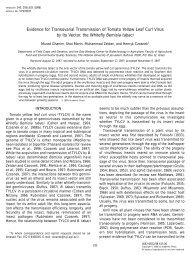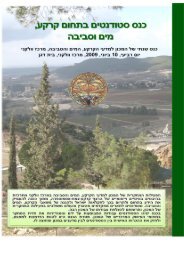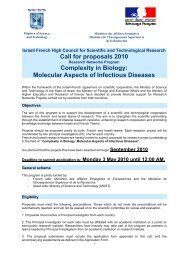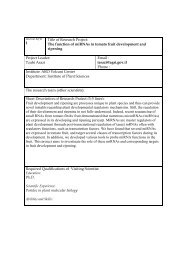6 Mali Talmor-Neiman et al.Figure 3. Predicted secondary structures <strong>of</strong>miR1219a polycistronic pri-mi<strong>RNA</strong>. miR1219a<strong>and</strong> miR1219b sequences are highlighted in gray<strong>and</strong> light gray respectively.member <strong>of</strong> the miR535 family (Figure 3b). However,Pp-MIR533a that is predicted to encode the 21-nucleotidemiR533a is also predicted to encode the 22-nucleotidemiR533b (Figure 2), <strong>and</strong> thus we cannot exclude thepossibility that miR533b is a processing variant <strong>of</strong>miR533a. In addition, Pp_13 <strong>and</strong> Pp_31 were found to beidentical to Pj_10 <strong>and</strong> Pj_170, respectively, <strong>and</strong> Pp_53 <strong>and</strong>miR1222 had 90.5% identity to Pj_201 (Figure 4c) <strong>and</strong> Pj_62(Figure 4d), respectively, raising the possibility that thesesmall <strong><strong>RNA</strong>s</strong> represent conserved mi<strong><strong>RNA</strong>s</strong> in mosses(Table 1).As pri-mi<strong><strong>RNA</strong>s</strong> are capped <strong>and</strong> polyadenylated noncoding<strong><strong>RNA</strong>s</strong>, such pri-mi<strong><strong>RNA</strong>s</strong> would appear as non-codingexpressed sequence tags (ESTs) (Zhang et al., 2005). ABLASTN search against the P. patens EST database (http://moss.nibb.ac.jp/blast/blast.html) revealed that Pp-MIR1217<strong>and</strong> Pp-MIR1218 were identical to the non-coding ESTcontigs 14150 <strong>and</strong> pph34n07, respectively. These findingssupport the characterization <strong>of</strong> Pp_101 <strong>and</strong> Pp_104 asmi<strong><strong>RNA</strong>s</strong> (miR1217 <strong>and</strong> miR1218, respectively) that areencoded in capped <strong>and</strong> polyadenylated pri-mi<strong>RNA</strong>. Thus,the analysis presented so far provides supporting evidencefor the identity <strong>of</strong> 10 new mi<strong><strong>RNA</strong>s</strong> (miR1210, miR1212,miR1213, miR1217, miR1218, miR1219a, miR533b, miR533c,miR535b <strong>and</strong> miR1222), two predicted mi<strong><strong>RNA</strong>s</strong> (miR1219b<strong>and</strong> Pp_miR390b) <strong>and</strong> seven mi<strong>RNA</strong>* in moss. The rest<strong>of</strong> the small <strong><strong>RNA</strong>s</strong> (Pp_18/miR1211, Pp_26, Pp_44, Pp_55/miR1214, Pp_63/miR1215, Pp_75/miR1216, Pp_107/miR1220,Pp_114/miR1221 <strong>and</strong> Pp_117/miR1223), which correspondedto a predicted pre-mi<strong>RNA</strong> foldback structure (except Pp_82,Pp_112 <strong>and</strong> Pp_115), were characterized as c<strong>and</strong>idatemi<strong><strong>RNA</strong>s</strong> (Table 1).ª 2006 The AuthorsJournal compilation ª 2006 Blackwell Publishing Ltd, The Plant Journal, (2006), doi: 10.1111/j.1365-313X.2006.02768.x
<strong>Novel</strong> mi<strong><strong>RNA</strong>s</strong> <strong>and</strong> mi<strong>RNA</strong> <strong>biogenesis</strong> <strong>intermediates</strong> in moss 7(a)(b)(c)(d)Figure 4. Homology <strong>of</strong> newly identified mi<strong><strong>RNA</strong>s</strong> to known mi<strong><strong>RNA</strong>s</strong> <strong>and</strong>Polytrichum juniperinum cloned small <strong><strong>RNA</strong>s</strong>.(a–d) Sequences were aligned with the CLUSTALW program. Identical <strong>and</strong>conserved nucleotides are labeled in upper case letters. Lower case lettersrepresent changes in nucleotide sequences in some group members. Pj,Polytrichum juniperinum.Several cloned small <strong><strong>RNA</strong>s</strong> represent <strong>intermediates</strong> <strong>of</strong>pre-mi<strong>RNA</strong> processingOur folding analysis revealed that Pp_82 matched the root <strong>of</strong>the putative miR1219a precursor Pp-MIR1219a just threenucleotides upstream <strong>of</strong> miR1219a (Figure 5a, underlined).In addition, Pp_112 <strong>and</strong> Pp_115 were found to be identical tothe putative Pp-miR319b precursor Pp-MIR319d. They matcheda region in its elongated stem between PpmiR319b:Pp-miR319b*<strong>and</strong> the loop structure (Figure 5b,single <strong>and</strong> double underlined). Moreover, Pp_112 <strong>and</strong>Pp_115 are predicted to complement each other with twonucleotides <strong>of</strong>fset reminiscent <strong>of</strong> a mi<strong>RNA</strong>:mi<strong>RNA</strong>* duplex(Figure 5b), suggesting that their <strong>biogenesis</strong> is mediated bya DICER-like protein.Expression analysis <strong>of</strong> newly identified mi<strong><strong>RNA</strong>s</strong>The mi<strong><strong>RNA</strong>s</strong> that we previously characterized in moss wererelatively abundant in the protonema small <strong>RNA</strong> library(Arazi et al., 2005). Conversely, 15 out <strong>of</strong> the 19 new c<strong>and</strong>idatemi<strong><strong>RNA</strong>s</strong> were identified only once in the small <strong>RNA</strong>library, implying that their abundance in the protonemashould be relatively low. Consistent with that, their expressionin the moss gametophyte could be detected by Northernblots only on 100 lg samples <strong>of</strong> total <strong>RNA</strong> extracted<strong>from</strong> 8–10-day-old protonema <strong>and</strong> 45-day-old gametophoreor in a low-molecular-weight <strong>RNA</strong> fraction isolated <strong>from</strong>500 lg <strong>of</strong> protonema total <strong>RNA</strong>. Northern blots confirmedthat 14 out <strong>of</strong> 16 representative mi<strong><strong>RNA</strong>s</strong> tested were stablyexpressed in the gametophyte, which reinforced theiridentity as authentic mi<strong><strong>RNA</strong>s</strong> (Figure 6). miR1210, miR1213,miR1214, miR1218, miR1221, miR1222 <strong>and</strong> miR1223 weredetected almost exclusively in mature gametophores <strong>and</strong>were barely detectable in the protonema (Figure 6, lane G),consistent with their low abundance in the protonema library.miR1211, miR1212, miR1215, miR1216, miR1217,miR1219a <strong>and</strong> miR1220 could be detected only in concentratedprotonemal low-molecular-weight <strong>RNA</strong> (Figure 6,lane C), suggesting that they are expressed at very lowsteady state levels in the gametophyte. This may be becausethey are expressed only under particular growth conditions,in specific cell types or mainly in a developmental stage suchas the sporophyte that was not tested in this study. Multipleb<strong>and</strong> signals <strong>of</strong> sizes bigger than 21 nucleotides weredetected with probes complementary to Pp_26 <strong>and</strong> Pp_44(data not shown), <strong>and</strong> therefore the identity <strong>of</strong> these c<strong>and</strong>idatesas mi<strong><strong>RNA</strong>s</strong> could not be confirmed.Predicted targets <strong>of</strong> newly identified mi<strong><strong>RNA</strong>s</strong>To identify the potential targets <strong>of</strong> newly identified mi<strong><strong>RNA</strong>s</strong>,we first used PATSCAN (Dsouza et al., 1997) to search theP. patens public EST database for m<strong><strong>RNA</strong>s</strong> that were(a)(b)Figure 5. Physcomitrella patens cloned small <strong><strong>RNA</strong>s</strong> that represent <strong>intermediates</strong> <strong>of</strong> pre-mi<strong>RNA</strong> processing.(a) Sequence <strong>of</strong> Pp-MIR1219a stem <strong>and</strong> loop. The sequences <strong>of</strong> miR1219a, miR1219a* <strong>and</strong> Pp_82 are bold-face, gray boxed <strong>and</strong> underlined, respectively.(b) Sequence <strong>of</strong> Pp-MIR319d stem <strong>and</strong> loop. The sequences <strong>of</strong> Pp-miR319b, Pp-miR319b*, Pp_112 <strong>and</strong> Pp_115 are bold-face, gray boxed, underlined <strong>and</strong> doubleunderlined, respectively.ª 2006 The AuthorsJournal compilation ª 2006 Blackwell Publishing Ltd, The Plant Journal, (2006), doi: 10.1111/j.1365-313X.2006.02768.x
















